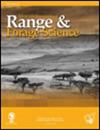二氧化碳引起的C4草可燃性变化是否会加剧稀树草原树木的侵蚀?
IF 1.9
4区 环境科学与生态学
Q3 ECOLOGY
引用次数: 3
摘要
火通过限制对热敏感的树木幼苗的补充,在维持热带稀树草原的树-草平衡中起着重要作用。然而,由于草层可燃性的改变,在二氧化碳浓度增加的情况下,火灾行为可能会发生变化。在这里,我们确定了预测的未来二氧化碳浓度的影响,以及它如何与水分有效性相互作用,对草的可燃性和影响可燃性的特性,并揭示了支撑这些反应的生理机制。利用广泛分布的C4稀树草原草,Themeda triandra,作为模型,我们发现,在二氧化碳浓度升高(800 ppm)下,水利用效率的提高导致了更大(更大的地上生物量),但更湿(更高的水分含量)的草燃料负荷,在干旱条件下固化速度较慢。这些变化与点火时间的增加、燃烧时间的减少和预测传播率的降低有关。我们在国家层面(南非)模拟了改变的草可燃性对火灾行为的影响,发现在二氧化碳升高的情况下,火灾蔓延大规模减少,减轻了预测的干旱增加和火线强度边际增加的相反影响。二氧化碳引起的火灾频率、蔓延或强度的减少可能对稀树草原植被动态产生严重影响,可能加剧世界各地这些生态系统中已经出现的树木侵蚀。本文章由计算机程序翻译,如有差异,请以英文原文为准。
Could CO2-induced changes to C4 grass flammability aggravate savanna woody encroachment?
Fire plays an important role in maintaining the savanna tree-grass balance by limiting the recruitment of heat-sensitive tree seedlings. However, fire behaviour may change under increasing CO2 concentrations, due to altered flammability of the grassy layer. Here, we determined the effect of predicted future CO2 concentrations, and how it interacts with water-availability, on grass flammability and traits influential to flammability, and uncovered the physiological mechanisms underpinning these responses. Using the widespread C4 savanna grass, Themeda triandra, as a model, we found that improved water-use efficiency under elevated CO2 (800 ppm) resulted in a larger (greater aboveground biomass), but wetter (higher moisture content) grass fuel load, that cured at a slower rate under drought conditions. These changes were associated with increased time to ignition, reduced flaming times and reduced predicted rate of spread. We modelled the effect of altered grass flammability on fire behaviour at a national level (South Africa), finding large-scale reductions in fire spread under elevated CO2, mitigating the converse effects of predicted increases in aridity, and marginal increases in fireline intensity. CO2-induced reductions in fire frequency, spread or intensity could have serious implications for savanna vegetation dynamics, possibly exacerbating the woody encroachment already seen in these ecosystems across the world.
求助全文
通过发布文献求助,成功后即可免费获取论文全文。
去求助
来源期刊

African Journal of Range & Forage Science
ECOLOGY-ENVIRONMENTAL SCIENCES
CiteScore
4.00
自引率
14.30%
发文量
35
审稿时长
>12 weeks
期刊介绍:
The African Journal of Range & Forage Science is the leading rangeland and pastoral journal in Africa. The Journal is dedicated to publishing quality original material that advances rangeland ecology and pasture management. The journal aims to publish research of international importance from any region, but as an African journal, we are particularly interested in research from Africa and relevant to the continent. The Journal promotes both science and its application and authors are encouraged to explicitly identify the practical implications of their work. Peer-reviewed research papers and research notes deal primarily with all aspects of rangeland and pasture ecology and management, including the ecophysiology and biogeochemistry of rangelands and pastures, terrestrial plant–herbivore interactions (both domestic and wild), rangeland assessment and monitoring, effects of climate change on rangelands, rangeland and pasture management, rangeland rehabilitation, ecosystem services in support of production, conservation and biodiversity goals, and the identification and development of intensive and semi-intensive pasture and forage resources to meet livestock production needs. Articles highlighting transdisciplinary linkages among biophysical and social sciences that support management, policy and societal values are particularly encouraged. The Journal includes relevant book reviews and invited perspectives that contribute to the development of range and forage science. Letters to the editor that debate issues raised in the Journal are acceptable. The African Journal of Range & Forage Science is the official journal of the Grassland Society of Southern Africa.
 求助内容:
求助内容: 应助结果提醒方式:
应助结果提醒方式:


